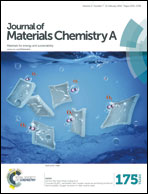Porous Ge@C materials via twin polymerization of germanium(ii) salicyl alcoholates for Li-ion batteries†
Abstract
The germylenes, germanium(II) 2-(oxidomethyl)phenolate (1), germanium(II) 4-methyl-2-(oxidomethyl)phenolate (2) and germanium(II) 4-bromo-2-(oxidomethyl)phenolate (3) were synthesized and their thermally induced twin polymerization to give organic–inorganic hybrid materials was studied. The compounds 1–3 form oligomers including dimers, trimers and tetramers as a result of intermolecular coordination of the benzylic oxygen atom to germanium. The structural motifs were studied by single crystal X-ray diffraction analysis and DFT-D calculations. Thermally induced twin polymerization of these germylenes gave hybrid materials based on germanium-containing phenolic resins. Carbonization of these resins under reductive conditions resulted in porous materials that are composed of germanium and carbon (Ge@C materials), while oxidation with air provided non-porous germanium dioxide. The porous Ge@C materials were tested as potential anode materials for rechargeable Li-ion batteries. Reversible capacities of 540 mA h g−1 were obtained at a current density of 346 mA g−1 without apparent fading for 100 cycles, which demonstrates that germanium is well accessible in the hybrid material.


 Please wait while we load your content...
Please wait while we load your content...